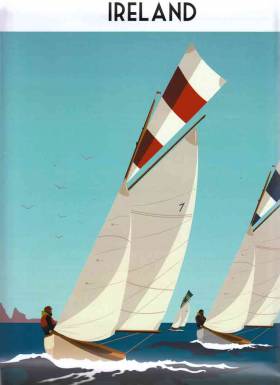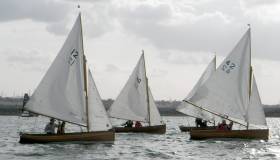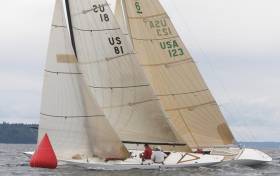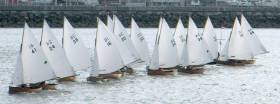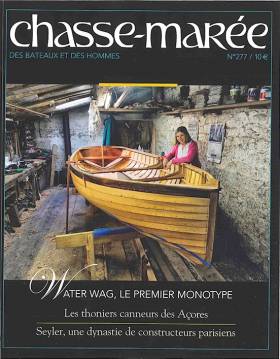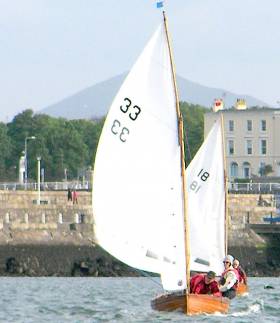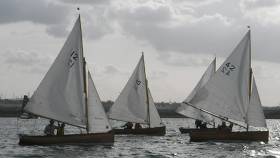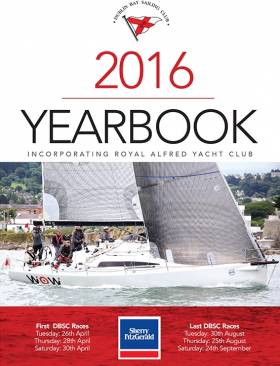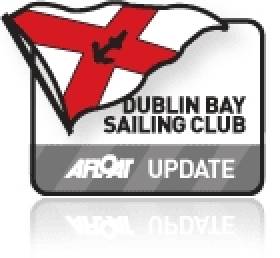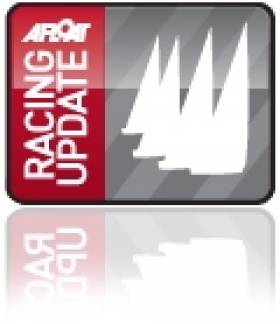Displaying items by tag: Water Wag
Irish Sailing's Classic Boats Get The French Morbihan Mystique
Three weeks hence from this morning, on Saturday May 19th, an unlikely convoy of vehicles with a very special collection of unique vintage boats and people will emerge in Cherbourg from Irish Ferries’ ship just in from Rosslare writes W M Nixon. Meanwhile, well to the west in northern Brittany, a similarly rare group with antique boats of a different type will have disembarked in Roscoff from the Brittany Ferries vessel from Cork. By that night, if all goes according to plan, both groups – people and boats alike - will be united a long way away, in the little port of Arradon on the shores of the Morbihan, the island-studded inland sea at the heart of its own Department, the most southerly part of Brittany.
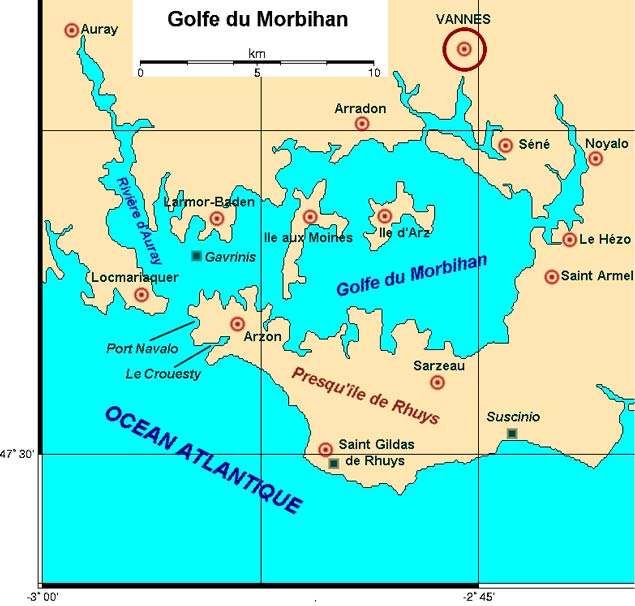 A sailing paradise. In detail, there are sixty islands in the Morbihan. The Irish crews in the Water Wags and Howth 17s will be based at Arradon on the north shore.
A sailing paradise. In detail, there are sixty islands in the Morbihan. The Irish crews in the Water Wags and Howth 17s will be based at Arradon on the north shore.
The Irish classic boats and those who sail them will have arrived to immerse themselves in the fleet of more than 1,300 other unusual craft in a very French celebration of sailing and pride in individualistic boat ownership. It’s a wonderfully complex biennial celebration which uses the magic waters of the Morbihan, where sea and land completely intertwine in the midst of the sweetest countryside with enchanting village ports, to provide a unique playground for boats of all types and sizes.
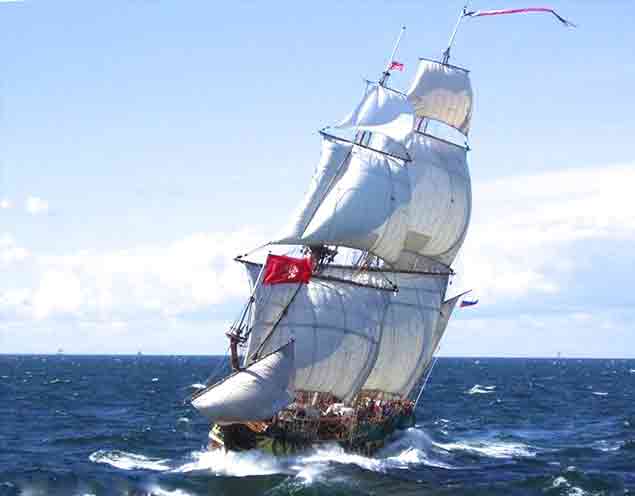 The replica of Peter the Great’s 1703-built Shtandard will be one of the largest vessels at the Morbihan.
The replica of Peter the Great’s 1703-built Shtandard will be one of the largest vessels at the Morbihan.
At the time of writing, they’re expected to range in size from the extraordinary Russian re-creation of Peter the Great’s huge warship of 1703, the Shtandart, right down to a selection of the sometimes decidedly unusual yet effective little craft which emanate from the creative minds to be found in Francois Vivier’s design office. In between, we’ve everything from the America’s Cup 12 Metre France through a comprehensive selection of traditional sailing fishing boats and classic yacht from several maritime nations, and on through a goodly fleet of other traditional craft with a strong representation of the Bantry Boats, until at the lower end of the size scale, we find some little boats which are very odd indeed, owner-designed craft which can best be categorized somewhere on the scale which ranges from Rather Quirky to Utterly Bonkers.
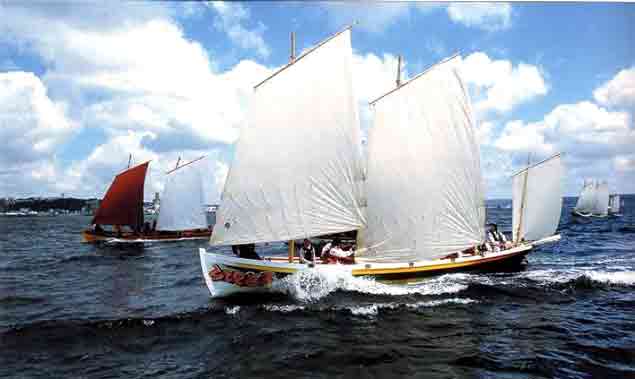 Bantry Boats racing in France. Based on the ship’s boat left behind in Bantry Bay after the failed invasion of 1796, the Bantry boat was stored for more than a hundred years at Bantry House before being moved to the National Museum. Under an iniative inspired by Hal Sisk, they are now the basis of a lively fleet on both sides of the Atlantic, and will be a feature of the Morbihan Week.
Bantry Boats racing in France. Based on the ship’s boat left behind in Bantry Bay after the failed invasion of 1796, the Bantry boat was stored for more than a hundred years at Bantry House before being moved to the National Museum. Under an iniative inspired by Hal Sisk, they are now the basis of a lively fleet on both sides of the Atlantic, and will be a feature of the Morbihan Week.
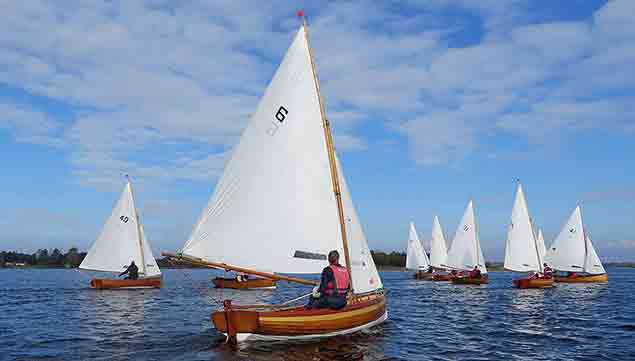 They’re in better heart than ever. The Water Wags at a recent “training weekend” at Killenure on Lough Ree. Next month they will be making their second visit to the biennial Morbihan Week in southern Brittany.
They’re in better heart than ever. The Water Wags at a recent “training weekend” at Killenure on Lough Ree. Next month they will be making their second visit to the biennial Morbihan Week in southern Brittany.
In the midst of the huge fleet, there’ll be twelve Water Wags and six Howth 17s from Ireland. Small and all as they are by comparison with some of the enormous traditional fishing craft and Tall Ships taking part, they will be accorded honoured status partly on account of age. The Water Wags of 1887 origin, with the present class a re-worked larger design from 1900, introduced the One-Design concept. And as the Howth 17s are of 1898 origin, they are accorded the special honour of being the world’s oldest one design keelboat class still sailing as originally designed.
 Howth 17s in full cry. They will be making their first visit to the Morbihan festival, but their newest sister-ship is being built nearby at Skol ar Mor.
Howth 17s in full cry. They will be making their first visit to the Morbihan festival, but their newest sister-ship is being built nearby at Skol ar Mor.
Further to all that, both classes bring international status through coming from Ireland, and few have come further, even if the little Irish boats are sensibly using the ferries. But we will also see Irish Sea representation with boats which have sailed there, with the beautifully restored classic Laurent Giles-designed Carbineer 46 Sylvana voyaging from Northern Ireland, while the irrepressible Joe Pennington from the Isle of Man is entered with his restored 1895-built 36ft Manx longliner Master Frank, which might find it interesting to have a spot of competition with the comparable French-based Essex smack Unity of Lynn.
However, for the little Irish boats, it’s a formidable logistical challenge. The Water Wags - in which the Olympic Mother Cathy MacAleavey has been setting the racing pace of late, though David MacFarlane won on Wednesday – are in good hands as Carol O’Rourke is coordinating their arrangements. But anyway they’ve useful experience here, as seven of them travelled to the 2015 Semaine du Golfe du Morbihan, and eight came back. They returned with a new boat for Adam Winkelmann which had been built to the class’s ancient designs by Mike Newmeyer and his team at the inspirational boat-building school Skol ar Mor.
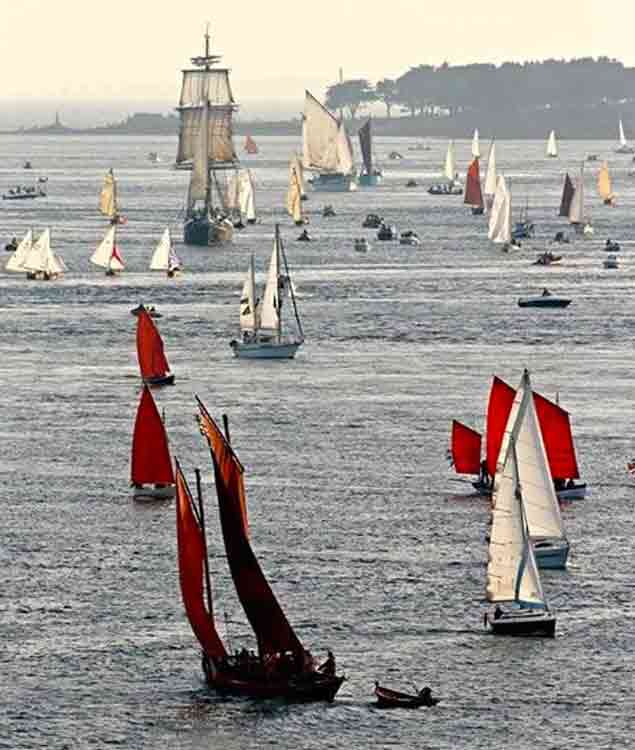 Eclectic fleet......the Morbihan Fesitval in 2015. Four of the Water Wags are just about visible left centre
Eclectic fleet......the Morbihan Fesitval in 2015. Four of the Water Wags are just about visible left centre
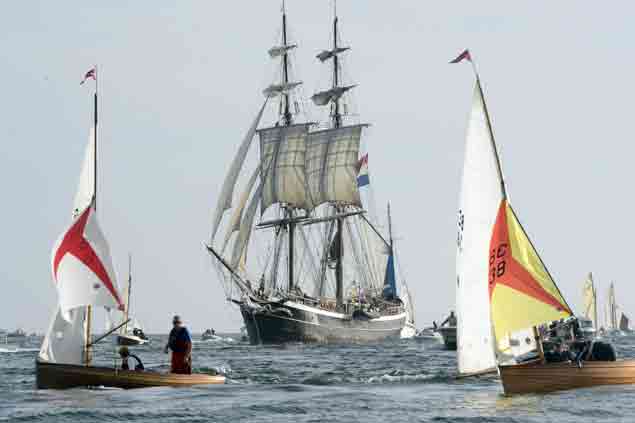 The popular Dutch sail training ship Morgenster was a welcome visitor to the festival in 2015, and is seen here approaching the entrance to the Morbihan in company with a couple of Water Wags
The popular Dutch sail training ship Morgenster was a welcome visitor to the festival in 2015, and is seen here approaching the entrance to the Morbihan in company with a couple of Water Wags
Skol ar Mor – which is located near the entrance to the Morbihan – is currently building a new Howth 17 for Ian and Judith Malcolm, but she won’t be finished until July as her construction is timed to phase in with the school’s term periods. But in any case, the Malcolms are keen to make their debut for the Howth 17s at Morbihan with their 1898-vintage boat Aura, which they’ve owned, lovingly cared for and raced very regularly since 1980.
It’s not the first time the Howth 17s have travelled far from their ancestral home, in fact it’s not the first time they’ve been to France, as a trio went to the Brest Festival in 1972. But road travel technology for little old boats wasn’t so advanced 45 years ago, so it wasn’t until 1998 that another road migration was taken on, with seven of them going to Belfast Lough to celebrate their centenary at their birthplace at Carrickfergus. They sailed the 90 miles home.
Then in 2005 they’d a seriously major movement, when an incredible 15 managed to get to the Glandore Classics involving an efficiently-organised set of low loaders which could take the boats down to West Cork three or even four at a time.
The Howth 17s are nothing if not individualistic, so the regimentation essential to the success of this expedition was exhausting for them. It took a while for the normal busy season of racing (usually they’ve sixty races a year) to resume once they’d got home. So since then, they’ve been building up a group of owners within the class who have proper road trailers, and that was the means used to get seven boats to Belfast Lough for last year’s 150th Anniversaries of Carrickfergus Sailing Club and Royal Ulster Yacht Club, together with the celebration of the yacht and boat-building achievement of the John Hilditch yard at Carrickfergus.
 The opportunity to compare different rigs and boat types at the Morbihan is unrivalled. This is the Looe Lugger Our Boys of Plymouth..........
The opportunity to compare different rigs and boat types at the Morbihan is unrivalled. This is the Looe Lugger Our Boys of Plymouth..........
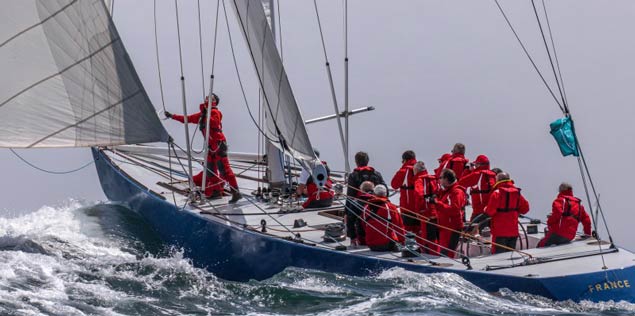 ......and this is the former America’s Cup 12 Metre France
......and this is the former America’s Cup 12 Metre France
But there’s a heck of a difference between taking just part of a morning to road-trail mostly on motorways from Howth to Bangor, and trailing your boat from Dublin to the Morbihan via the Rosslare-Cherbourg ferry. The Water Wags know they can do it, but for the much heavier Howth 17s and their interesting selection of four-wheel-drive towing vehicles, they’re facing a total haul of 540 kilometres, 348 of them in France.
Naturally, there are those who’ll say that boats of this vintage should live pampered lives. But the Howth 17s are nothing if not adventurous, and Irish Ferries have been so much taken with all this that four of the boats and their towing vehicles are travelling the ferries there and back for free, so between them the six travelling equipes have only had to divvy up for two boats’ cost.
Nevertheless as two of the boats – Aura and Roddy Cooper’s Leila - are from the original 1898 Hilditch-built five, they’re moving a uniquely precious cargo on a project very far removed from their origins. So far removed, in fact, that I can’t help but imagine John Hilditch urging on his men on a Monday morning early in the Spring of 1898 with the inspiring words: “C’mon, lads, we have to build these new Howth boats strong and true, for in 119 years time their owners will want to trail them the 217 miles from Cherbourg to Vannes on some sort of road cart.”
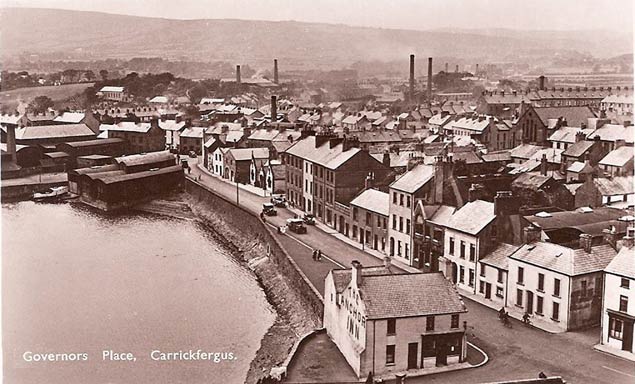 Change of scene. The Howth 17s were built in Carrickfergus in 1898 in Hilditch’s Boatyard in those black sheds on the waterfront at the head of the harbour in an industrial town.......
Change of scene. The Howth 17s were built in Carrickfergus in 1898 in Hilditch’s Boatyard in those black sheds on the waterfront at the head of the harbour in an industrial town.......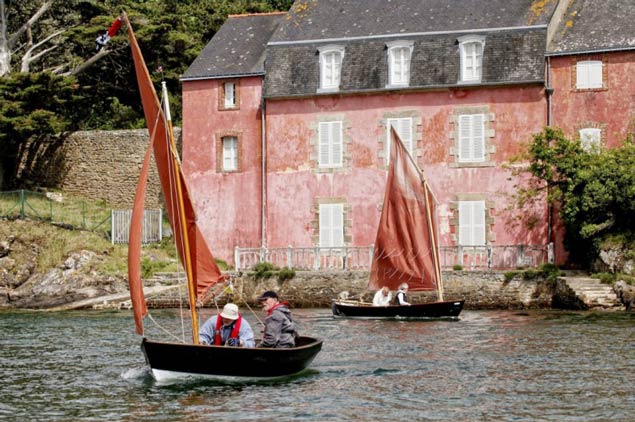 ....but next month they’ll be sailing in these agreeable surroundings in the heart of the Morbihan
....but next month they’ll be sailing in these agreeable surroundings in the heart of the Morbihan
Quite. Either way, it will be an exhausting journey, but it’s the sort of project which re-energises those involved as it moves along, and once they’ve got to the Morbihan, the Water Wag and Howth 17s sailors will find themelves among kindred spirits. It’s something they need from time to time. Only the other day I was asked to reveal to a non-sailor what the Water Wags are all about in 2017, and found it very challenging. For how can you explain the inexplicable?
Around the Morbihan, there’ll be no need to explain. Yet even in France supposedly among members of the same nautical religion, the Howth 17s and the Water Wags will find themselves slightly at odds with the crew of some other boat types, as the essence of both the Irish classes is that they race a lot, so much so that both classes are healthier than ever. But that is not always to the taste of all those who simply love old boats for themselves, and find that keeping them in good order and sailing them in non-competitive style on various expeditions within the ambit of the Semaine du Golfe du Morbihan is all that is required.
But the Morbihan has so much to offer that there’s something for everyone, and for smaller racing boats that want racing, there’ll be racing available. As for others who simply like sport in sailing challenging bits of sea, the tides in the Morbihan whoosh in and out through the narrow entrance with such vigour that many treat it like a nautical ski slope.
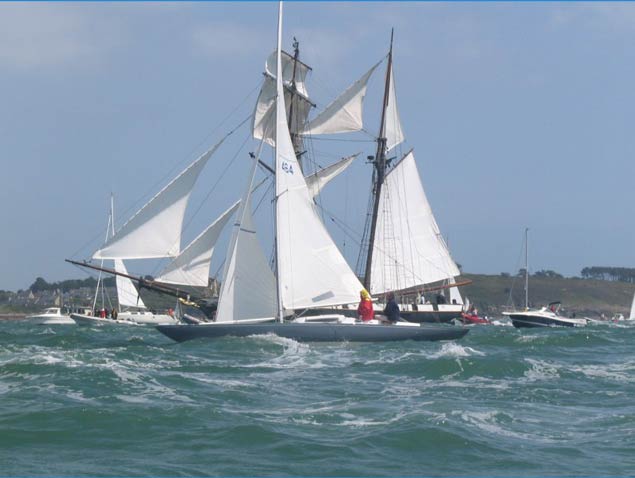 The manageable liveliness of the tide-riven waters in the Morbihan entrance is integral to the way the event is staged.......
The manageable liveliness of the tide-riven waters in the Morbihan entrance is integral to the way the event is staged.......
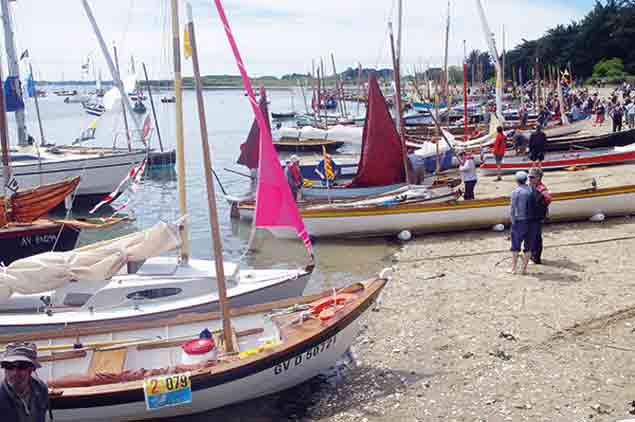 ......but for balance, sheltered beach time is expected
......but for balance, sheltered beach time is expected
This is markedly unlike the attitude at the entrance to Strangford Lough. There, the tide-race on the bar is admittedly on a bigger scale, but it’s regarded as something to be avoided. At the Morbihan by contrast, there are small boat sailors who’ll spend their whole day crawling in the eddies against the tide, and then returning with it in the middle of the full exuberant burst of the rip.
For those with more leisurely tastes, there are all sorts of waterside establishments where lunch can go on for ever, but be very sure to have secured your table by 12:30pm. And as for visiting other boats, that too can go on for ever.
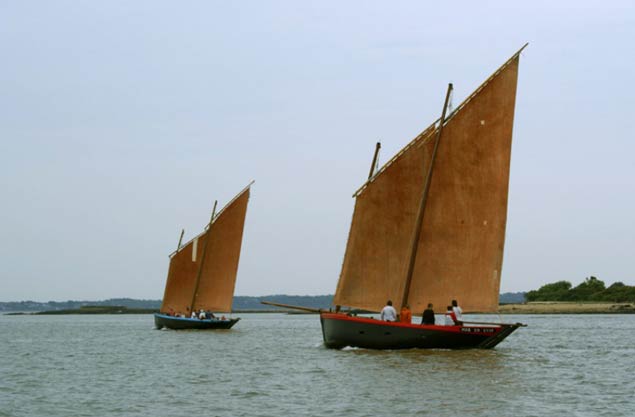 The sinagot is the indigenous traditional fishing boat of the Morbihan
The sinagot is the indigenous traditional fishing boat of the Morbihan
Certainly there are some with which the Howth folk should link up. A noted presence will be the McGruer 8 Metre Cruiser/Racer Orana of 1959 vintage. For many years she was based in Howth under Johnny Pearson’s ownership, and she had her moments, including winning the 1966 RORC Beaumaris-Cork Race overall. She was the first yacht I ever did the Lambay Race aboard, and when you do your first Lambay Race with the likes of Johnny Pearson, Bob Fannin and Brendan Murray, you learn an awful lot about what living in Howth is going to involve, and you even learn a little about racing round Lambay.
 The 1959 McGruer-designed 8 Metre Cruiser-Racer Orana was Howth-based for many years, and was overall winner of the 1966 RORC Beaumaris-Cork Race. After being under the radar for decades, she has re-emerged in French ownership as a participant at Morbihan Week 2017
The 1959 McGruer-designed 8 Metre Cruiser-Racer Orana was Howth-based for many years, and was overall winner of the 1966 RORC Beaumaris-Cork Race. After being under the radar for decades, she has re-emerged in French ownership as a participant at Morbihan Week 2017
Orana had been off the radar for decades, but now she has re-emerged, spic and span in French ownership and ready to strut her stuff in the Morbihan in three weeks time when she’ll be part of a mind-blowing feet. In fact, so diverse is the fleet, that while most of it will be the challenge of recognising what’s going past, some are worth seeking out directly, and one such is surely the famous Pen Duick, Eric Tabarly’s original boat, a Fife-designed 15-tonner which started life in 1898 at Carrigaloe on Cork Harbour.
Originally, she was given the unlovely name of Yum, and her owner, one Adolphus Fowler of the Royal Munster YC, was evidently feeling prosperous, for at the same time he had the Carrigaloe yard built him the Cork Harbour One Design Jap.
Both boats still sail the sea, but mercifully Yum soon received a pleasanter name as she was quickly sold, and she is now immortalised as Pen Duick, the eternal beauty brought back to life by Eric Tabarly to be an extraordinary link between William Fife of Scotland, Cork Harbour in Ireland, and all that is best in French sailing in Brittany.
In a league like this, the little boats from Ireland will need to do something special to fulfill their role. But I think that the poster that the Howth 17s commissioned from local artist Carol O’Mara for display on the various sites around the Morbihan is definitely a step in the right direction. There’ll be so many messages flying around from all sources that something which says what it wants to say so well, so simply, and so directly will make the most impact.
Dun Laoghaire endured strong northerly winds for several days over the past week, so, there was a fear that many Water Wag owners would give the first race a miss. However, on 26th April, eighteen Water Wags competed in the first race for The Newsom Memorial Cup including Rio Olympic Silver medalist Annalise Murphy.
The wind was still coming from the north, blowing at about 7 knots, so, the race committee under Tom Hudson, laid a windward-leeward course with the windward mark located in the harbour mouth. At the start, only the Water Wags in the front line had enough wind to power away. As the fleet split with most boats heading towards the west, Cathy MacAleavey’s Mariposa new Water Wag, only launched last week led the fleet. At the windward mark the order was Mariposa, Moosmie and Pansy which had taken the eastern side of the course. On the offwind leg, there was much blanketing from the fleet behind, and there was an even split between boats taking each of the leeward gate marks.
By the second windward mark David MacFarlane’s Moosmie was in the lead, with the Kilroys in Swift in second and Mariposa in third place. This order remained until the end of the third beat, at which time the wind had dropped to 4 knots, and the race committee decided to shorted the race. David and Patricia Corcoran in Peggy in 7th place were top competitors racing for The Hilpotsteiner Tankard in Division IB, with Fergus Cullen and Alice Walshe in Penelope one place behind.
Leading boat of Division 2 racing for the Phyllis Cup was Freddie sailed by Bairbre Stewart with new crew, Benno MacCormack who helped her to finish high up the fleet. Second in Division 2 was mother and daughter team of Kate and Amy O’Leary in Chloe. Next Wednesday the Water Wags will compete in the second leg of a series of three matches.
1st – 15, Moosmie, David MacFarland.
2nd - 38, Swift, Guy and Jackie Kilroy.
3rd. - 45, Mariposa, Cathy MacAleavey and Con Murphy
4th. - 41, Mollie, Annalise Murphy.
5th 42, Tortoise, William Prentice.
6th. 3, Pansy, Vincent Delany and Niamh Hooper.
7th. 47, Peggy, David and Patricia Corcoran.
8th. 16, Penelope,
9th. 43, Freddie
10th. 8, Barbara
11th. 34, Chloe
12th. 30, Sara
13th. 46, Mademoiselle
14th. 33, Eva
15th. 40, Swallow
16th, 44, Scallywag
17th. 10, Sprite
18th 31. Polly.
Honouring An Olympic Sailing Gold Medal of 68 Years Ago
These days Dermot O’Flynn, Director of Training in the Royal College of Surgeons in Ireland, does much of his sailing in a classic Water Wag dinghy in Dun Laoghaire and Dublin Bay. But he is a man of wide-ranging nautical experiences and interests, and he has a gem of a story to share with us here:
In life you get some opportunities to do the right thing, and for me this was one of them. In January 2014 my father Dermot O’Flynn, past President of the Royal College of Surgeons in Ireland, died suddenly at the wonderful age of 94. A father, a great surgeon, and a yachtsman who enjoyed any opportunity to be out and about near or on the sea, he left me many happy memories. And he also left me an Olympic Gold Sailing Medal from the 1948 London Olympic Games (understandably known as the Austerity Olympics) which was won by Jim Weekes, who had crewed on the winning American 6 Metre Llanoria.
She was designed by Sparkman & Stephens, and owned by Herman Whiton, who was a member of Seawanhaka Yacht Club on Long Island, New York. On the crew registration for the 1948 Olympics, Jim was listed as James Weekes and the rest of the crew from Seawanhaka Yacht Club were Herman Whiton, Alfred Loomis (who was one of the leading sailing journalists of his day), Michael Mooney & James Smith.
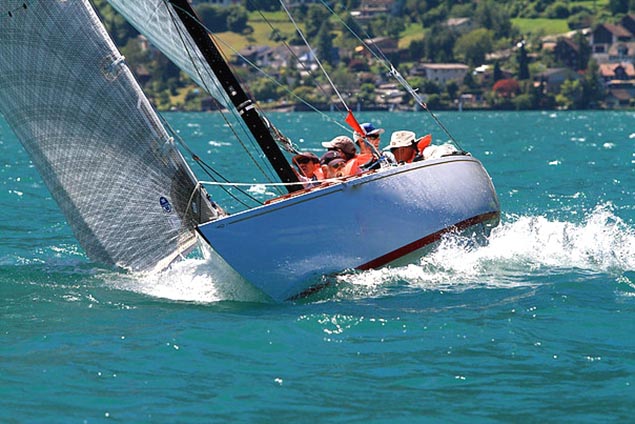 The veteran but beautifully restored Llanoria, European 6 Metre Classic Champion 2016
The veteran but beautifully restored Llanoria, European 6 Metre Classic Champion 2016
The 6 Metres were the largest and most prestigious of the yachts competing in the 1948 London Olympics, which also included Dragons, Swallows, Stars and the 12ft Firefly dinghy. The famous Danish sailor Paul Elvstrom won his first Gold Medal that year sailing a Firefly dinghy, so Jim and the crew were in good company.
My father was gifted the Medal in 1981 by James Weekes’ wife Kay, who had a been a long term patient and friend of my father. In the accompanying letter she wrote:
“This token comes with my deep affection, no other man deserves it better other than the one who won it, there are no sailors in my family, hand it down to one of yours when the time comes”
My father made the decision to hand down the medal to me probably because I survived the Fastnet Race in 1979 in a 30ft racing yacht, sailed across the Atlantic in 35-foot Camper & Nicholson sloop in 1981, managed a second overall in The Middle Sea Race, and loved sailing all types of boats whether they be dinghies, IRC racing machines, or classic cruising yachts. Yet after putting the medal under lock and key for a while, I came to the decision that the medal did not belong to me or my family, but should be returned to Seawanhaka YC, and so my journey started. Very quickly I discovered that there was only one living relative, named Townsend Weekes, who was also – surprise surprise….- a member of Seawanhaka YC, and he was delighted to hear the medal would be coming home.
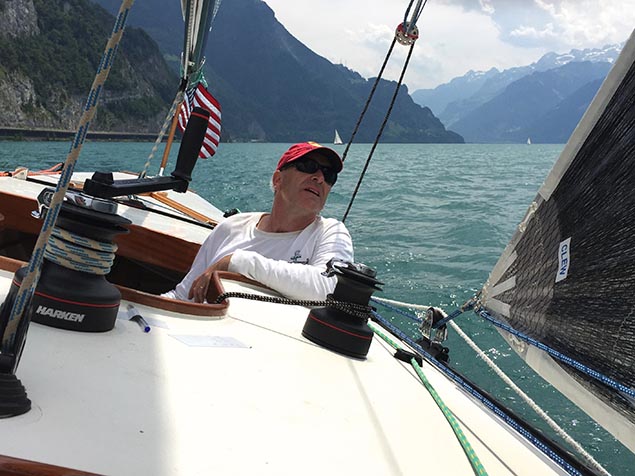 Dermot O’Flynn helming Llanoria on Lake Lucerne, July 2016
Dermot O’Flynn helming Llanoria on Lake Lucerne, July 2016
Townsend informed me that Jim was originally from Oyster Bay, Long Island, New York. He had three siblings, and the family have a long history with Oyster Bay, dating back to 1653 when Francis Weekes settled there. Jim’s grandfather was one of the earliest members of Seawanhaka Yacht Club, and both his brother Arthur and brother in-law Porter were Commodores of this yacht club.
Jimmy - as the family called him - was a terrific athlete who loved sailing and was the best rifle shot of his three brothers. Like his brothers, he had a distinguished career in the American Navy in World War 2, becoming an Executive Officer on a battle cruiser in the Pacific.
Nobody can remember how Jimmy got selected to sail on Llanoria for the Olympics in 1948 but obviously Herman Whiton liked the ‘cut of his jib’, and the Gold Medal sealed the success of their mutual respect.
James Weekes married Kay in 1962, and they moved to Dublin as they wished to live in Ireland, but sadly Jim died suddenly in 1977 at the age of 65. Kay and James had no family, however Kay had family from her first marriage, and they and other Weekes relatives in America had always wondered what happened to the gold medal, so they were intrigued – to say the least - to hear where it had ended up.
Having discovered the background to Jim Weekes, naturally my attention was drawn to the great Llanoria US 83, and what might have happened to her. My journey started by accident when I was delivering an Alden 54 called Tara from St Petersburg to Stockholm via the Finish Archipelago. We happened to spend two wonderful nights on the marina of Helsinki Yacht Club and the club has a half model of Llanoria, plus a photo of her winning the Seawanhaka Cup, for Llanoria had also won the 6 Metre Class in the 1952 Olympics in Helsinki – she is the only yacht to have won two Olympic Gold Medals.
My next port of call was the famous yacht designers Sparkman & Stephens in New York. They very kindly went through their records and found a line drawing of the yacht designed by Olin Stephens which they sent to me, however at that time they had no record of Llanoria’s present location.
But I kept digging for more information, and finally got in touch with Matt Cockburn, secretary of the Puget Sound 6 Metre Association in America’s Pacific Northwest, who gave me the great good news that Llanoria had been totally refurbished by her current owner Peter Hofmann, whose family had purchased her in 1980, and that she had just won the 6 Metre 2015 World Championships (Classic Division) at La Trinite Sur Mer on France’s Biscay coast, helmed by Eric Jespersen.
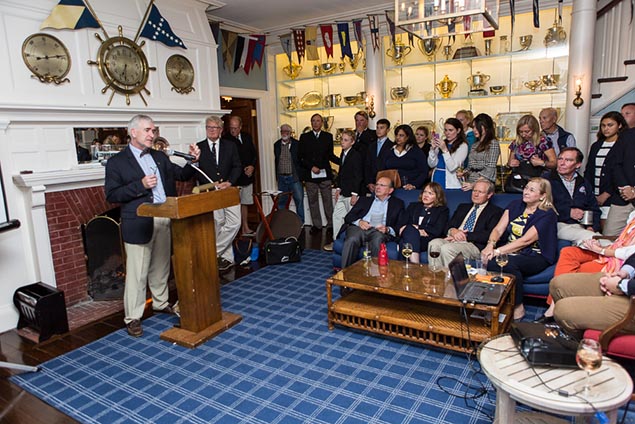 Reception at the Seawanhaka Yacht Club on Sunday October 2nd to hand over the James Weekes Memorial Trophy
Reception at the Seawanhaka Yacht Club on Sunday October 2nd to hand over the James Weekes Memorial Trophy
I then contacted Peter Hofmann who was fascinated by the story of the Medal, and he kindly agreed to me joining him and the crew of Llanoria for a sail as they prepared for the 6 Metre European Championships on Lake Lucerne in July 2016. What a joy it was to sail with a crew who knew their yacht so well, and to watch them tune the rig, adjust the sheets, move the mast and create the perfect sail shape for 6 Metre sailing in 8-10 knots of breeze.
Now it was time to move on to the next stage of the Gold Medal’s journey home. In memory of James Weekes I agreed with the Seawanhaka Yacht Club Commodore, Vice Commodore and Committee, through a Deed of Gift, to present the Medal to the Club as ‘The James Weekes Olympic Gold Memorial Trophy’
The trophy represents the coast line of Torbay on England’s south coast, venue of the 1948 Sailing Olympiad, in Irish Silver, with the Gold Medal suspended in the centre of the 1948’s 6 Metre racing area. It is placed on a piece of Irish Bog Oak which is more than 800 years old, chosen for the very personal reason that on the day my father died, his parish priest said to me on hearing the sad news: “Dermot, a great oak has fallen”
At the beginning of October, it gave me and my family great pleasure to present this Memorial Trophy to Seawanhaka Yacht Club, and l look forward over my lifetime to hearing about the sailors who win this trophy, and their successes both on and off the race course.
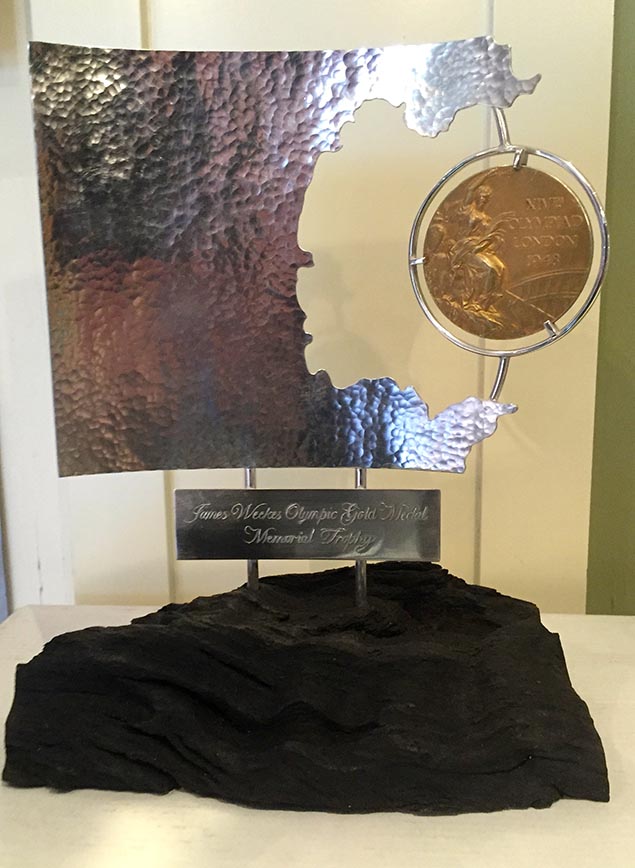 The James Weekes Olympic Gold Medal Memorial Trophy honours many cherished memories 68 years down the line since the Torbay Olympics.
The James Weekes Olympic Gold Medal Memorial Trophy honours many cherished memories 68 years down the line since the Torbay Olympics.
It was the Royal Irish Yacht Club Regatta. Unlike other classes the Water Wags compete in the regatta on Wednesday evening. At quarter to six, there was not a breath of wind on the harbour. Tom Hudson and his crew on the committee boat went out anyway, and laid a course.
Air temperature was in the high teens and the sun was out. It was a good evening for a sail.
Twenty-one Water Wags launched. The tide in the harbour was ebbing-. The unstable wind was offshore from the south-west.
By starting time at 18.45hrs., the breeze had picked up to at least 6 knots. For the first start the Little Tern and others were premature starters, and a general recall was enacted.
At the second start there was a definite bias at the pin end of the line, so that is where Mollie was stationed to get away cleanly. But it wasn’t to be, as there was a pile up caused by several Water Wags shooting the RIB located at the pin mark. The Water Wags starting 12 boat-lengths back along the line were able to start at speed, to clear the bunch up at the pin mark and streak away. It appeared that the closer one went to shore that the wind lost pressure, so several tacked onto port. Vincent Delany and Hilary Williams in the 110 year old Pansy managed to cross the starboard tackers who started nearer to the committee boat. At the windward mark the order was: Pansy, Gavotte, Mademoiselle and Moosmie.
On the off-wind leg the wind went slack, so good spinnaker handling was important. At the end of the second beat the order had changed to: Pansy, Gavotte, Moosmie and Little Tern.
The wind collapsed completely on the second run, and when gusts appeared, the directions was not predictable. At the finish at the end of four beats and three runs, the order was:
- 1. Pansy, Delany and Williams. RStGYC
- 2. Little Tern, Tim & Marcus Pearson. RStGYC
- 3. Swift, Guy & Jackie Kilroy, RIYC
- 4. Gavotte, Frank Guy & Owen McNally.RStGYC
- 5. Skee, Jonathan & Carol O’Rourke.
- 6. Mademoiselle, Adam Winkleman & Doug Smith.
- 7. Moosmie, David McFarlane
- 8. Penelope, Fergus Cullen & Alice Walsh.
- 9. Vela, Philip Mayne & Brian Bond.
- 10. Good Hope, Hal Sisk & Sue Westrup.
- 11. Coquette, Seymour Cresswell & Mary Aspied.
- 12. Nandor, Brian McBride & Stuart McBean.
- 13. Mollie, Cathy MacAleavey & Finn Murphy.
- 14. Peggy, David Corcoran.
- 15. Polly, Richard Mossop & Henry Rooke.
- 16. Eva, Orla Fitzgerald & Dermot O’Flynn.
- 17. Ethna, Bill Nolan.
- 18. Freddie, Bairbre Stuart.
- 19. Mary Kate, Ian McGowan.
- 20. Chloe, Ben McCormack.
- 21. Eros, Gavin Johnson.
Leading French maritime heritage publication Chasse–Marée features Dublin Water Wag sailor and builder Cathy MacAleavey on its lastest front cover. In a full length feature article, the magazine features the history of the world's first dinghy ('le premier monotype') that has its origins at Shankill beach in Co. Dublin from 1886. Olympian MacAleavey, who recently exhibited a new build of the 13–foot craft at the RDS is photographed on the front cover at Jimmy Furey's workshop on the river Shannon at Roscomon.
Built in Mountplunkett, Roscommon over the past 18 months by Jimmy Furey and Cathy Mac Aleavey, Wag No. 45 has been named Mariposa (Spanish for butterfly) and was launched during the annual Waterwag Club Shannon regatta held at Lecarrow on Blackbrink Bay, Lough Ree on September last. This season, Mariposa joined the growing number of Waterwags being raced in Dun Laoghaire.
The over 100–year–old class is one of the most active dinghy classes racing in Dun Laoghaire, regularly attracting 20 and 30–boat fleets. Last season, another brand new boat, No.46 was launched and sailed at Dun Laoghaire.
Read more by WM Nixon: Ireland's Invisible Boat Builders
Tortoise is First in Water Wag Race
On Wednesday 11th May the Water Wags competed for the third and final race of the first mini-series. The air temperature was reasonably warm and the wind was light, about 6 knots. There was a 200mm high lop in the harbour, which the Water Wags did not take kindly to. The wind was blowing from the North West- a direction famous for producing surprises. And on Wednesday, it did just that. There were 16 boats on the water including the brand new No. 47, Peggy, built by John Jones in Wales for David Corcoran. This is the 5th Water Wag built by Jones who finishes his boats to a beautiful standard. Remarkably, Peggy looked naked compared with the other Water Wags afloat, due to the light colouring of the planking. In time it will become darker, due to contact with sunlight.
The start line was close to the redundant ferry berth. The fleet got away on the first attempt. It was the Hoopers in Ethna who made the best start, and crossed the entire fleet on port. The pundits reckoned that with an ebbing tide, the flow out of the marine would push you backwards, whereas a tack toward the mouth of the harbour would have the boats travelling with a favourable tide. It was correct in theory, but in practice something else happened. Those who tacked off early were headed by about 20 degrees, while those who left it as late as possible to tack, came up trumps! It was William Prentice in Tortoise who rounded the mark off the west pier head first. Others soon after him included Kate O’Leary in Chloe, and Guy and Jackie Kilroy in Swift, and Jonathan and Carol O’Rourke in Skee. On the offwind leg, it was spinnakers up, and head for the starboard hand gate-mark to leeward. On the next beat the wind progressively swung to the west and all of the fleet laid the windward mark without tacking. There were place changes. Some boats stopped when they hit the waves, and progressively fell off to leeward. It paid to stay in clean wind. After three laps of the harbour reaching up and down the race was shortened. At the finish it was Tortoise first, Swift second and Moosmie pulled up from the back of the fleet.
12 Water Wags Start Summer Season in a Chilly 4 Degrees
With the air temperature in the afternoon of 4 degrees, it was looking like mid-winter. However, this did not deter twelve Water Wags from braving it on Wednesday evening in Dun Laoghaire Harbour writes Vincent Delany.
The breeze was about 12 knots, from the North east blowing through the harbour mouth. The windward mark of the 4 1/2 lap course was laid to the west of the area designated for the possible liner berth. The match was the first of a series of three matches for the Arthur Newsom Trophy (div 1A), Hilpotsteiner Tankard (div 1B) and Phyllis Trophy (div 2).
On the first beat all looked even-steven until it was realised that the Wags to windward were being lifted and the Wags to leeward were being headed. By the time they reached the windward mark, No. 38, Swift sailed by Guy and Jackie Kilroy had a short lead from No.15, Moosmie sailed by David and Sally MacFarlane and William Prentice in No.42, Tortoise. It was almost a run to the offset mark and a gybe to the leeward gate. The fleet were breaking up into two groups, the leaders and Division 1B. Richard and Henry in Polly struggled with finding some of the marks, so she did an extra lap of the course to ensure that the ‘tightened thread’ went around the correct marks. It is fantastic to realise that this noble action is likely to have an impact the final results in September.
The wind decreased to about 8 knots and there were place changes up and down the fleet. On lap two Moosmie contacted the windward mark and had to do a penalty turn. On lap three Swift engaged the mooring rope to the windward mark, and pulled it in until contact was made. In taking her penalty between the windward and offset marks, she allowed Moosmie past, and thus it remained to the end of the race. This responsible observation of the rules should be noted by some other classes in Dublin Bay.
Dublin Bay Sailing Club Launches New Racing Programme for 2016
Sherry FitzGerald estate agents have come on board for a three-year-deal as title sponsor of the Dublin Bay Sailing Club (DBSC) ahead of the 2016 summer season that gets under way in a fortnight.
The announcement comes with changes in this year’s sailing programme for Ireland’s biggest racing club, as heard today at the launch of its 2016 yearbook in the National Yacht Club, Dún Laoghaire.
‘Be proactive with evolution rather than be reactive to revolution’ is the slogan to bear in mind as the DBSC moves to accommodate demand for speedier, lighter craft, and increasingly popular asymmetric rigs, over classes that have seen continued decline over the past five years.
One notable exception, however, is the Water Wags class, the quintessential traditional wooden boat that’s bucking the trend.
Last year, with 29 boats on the register, Water Wags are probably even more numerous than they were in their Victorian heyday. The Wags have always had an active preservation programme which – allied with a strong class ethos, or esprit de corps – helps them to grow and flourish.
As for the DBSC’s 132nd season, which begins in the last week of April, Saturdays will now have room for three keelboat fleets over previous years’ two.
This follows the committee’s decision to support a new Mixed Sportsboat class that joins the Green Fleet along with Dragons, Flying 15s, Squibs, SB20s (who previously raced on Sundays) and, on occasion, Mermaids.
The biggest change for the established Red and Blue Fleets sees Cruisers 5, formerly White Sails, move from the latter to the front of the former for Saturdays only. Both fleets will continue to race as before, alternating between MacLir and the West Pier for their starts, though courses have been revised, with the assistance of Tim Goodbody and Brian Mathews, to exclude Zebra mark.
The Green Fleet will race from the Freebird and will compete for the most part on windward/leeward courses. The sailing instructions provide for triangular courses and even, if the opportunity arises, for trapezoid courses in the North East quadrant to the east of Zebra mark.
On Thursdays, the Mixed Sportsboat class joins the Red Fleet, while Cruisers 5 have now been split into two divisions, with potentially different courses, to manage their varying speeds and wide spread of handicaps, and make for fairer racing. The split does not apply on Saturdays when there is less possibility of boats being timed out.
On Sundays, and inspired by the success of the DMYC’s Frostbite series during the winter months, the DBSC hopes to encourage dinghy turnouts this season with two starts: PY/IDRA 14 at 2.15pm, and Fireballs three minutes later. The club also aims to accommodate any other interested centre-board boats.
The sailing instructions and course cards have been revised to cover the above, as well as a number of changes for class flags.
In 2016’s other big news, the Royal Alfred Yacht Club (RAYC) has now officially been incorporated into DBSC. The move should not affect racing to any noticeable degree.
This year will see three designated coastal races – on May 28th, July 30th and August 12th – which will carry the ‘Alfred’ label to mark the continuation of its ethos in the DBSC programme.
In addition, the once annual RAYC Bloomsday Regatta on June 16th will now be held by the DBSC in years when there are no other waterfront club regattas.
Read also: tomorrow's WM Nixon's Sailing on Saturday Blog on DBSC's 2016 Season
#waterwag – Dublin Bay Sailing Club doyen Carmel Winkelmann officiated at the launch of the newest Water Wag dinghy, Mademoiselle, No. 46 on Sunday at the Royal Irish Yacht Club.
The new 12–foot clinker dinghy was built for Bay sailors Adam Winkelmann and Doug Smith. The boat was built in Skol Ar Mor, France.
The Water Wag is the oldest one design dinghy in existence, having been devised in 1886 and formalised as a one design class in Ireland in 1887. The design (last modified in 1900) is still sailed to this day on Dublin Bay and is one of the most popular dinghies sailed on the capital's waters recording some notable turnouts of late.
Immediately after the champagne launch ceremony, the Water Wag class held its annual picnic race (which has been running since 1887) with a pursuit down to Dalkey Island and back. An exciting race down to the Island with the end of the ebb tide. Mademoiselle led for most of the way but Mollie managed to overtake her coming into Dalkey sound, with David McFarland in third.
On the return home, No 1 Ethna sailed by Bill Nolan and Niamh Hooper led out of Dalkey sound, Moosmie had to go back as she was over the line but came steaming up the inside to take the win with Ethna 2nd and Mollie 3rd so taking the overall win!
The class thanks 'Thyme Out' and the Bretzel Bakery for sponsoring the fabulous lunch on Dalkey Island. Also our thanks to Brian and Anne Craig and Michael O'Leary for acting as mother ships, Dara, Caoimhe and Eddie Totterdell who had just got in from Greece at 4 in the morning from holidays and made it out drive a rib for us, also to Sandy Aplin who did a sterling job of ferrying us in an out of the Island.
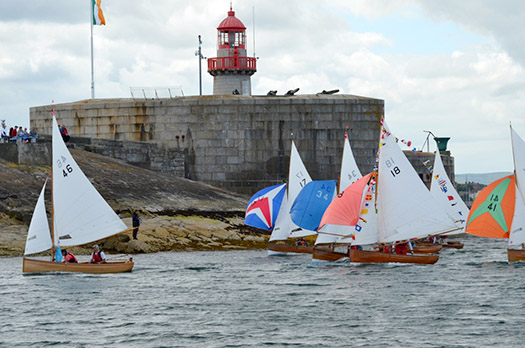
Mademoiselle (above and below) led the Wags on their annual picnic race to Dalkey Island after her launch. Photos Owen McNally


The Wags moor up off Dalkey Island (above) and go ashore for a picnic Photos Owen McNally

Results;
1st Moosmie
2nd Mollie
3rd Mademoiselle
4th Ethna
5th Skee
6th Barbara
7th Coquette
8th Good Hope
9th Chloe
#waterwag – After two weeks when the wind in Dun Laoghaire was two strong, the Water Wags competed on 14th. May in their first race series. The sun shone, there was 8 knots of wind from the east north east, and thirteen Water Wags turned up, for was to be a single race to decide the winner of the three trophies. Half the fleet were in France competing in La Semaine de Mor Bhion in Brittany, so the fleet numbers were depleted.
There was much interest to see how all the new owners would get on in their new vessels. Tim and Marcus Pearson in No.36, Little Tern showed that they have all the talent necessary to do well in a harbour race and finished in second place behind Bairbre Stewart and David Corcoran in No.43, Freddie, who dominated the race from beginning to end, and as winners of Division IB won the Hilpotsteiner Trophy. Remarkably this brother/ sister duo swap the helming role, with Bairbre steering the downwind legs.
Paul and Anne Smith in No. 30, Sara managed to outwit David and Anne Clarke who were previous owners of Sara, but now race in No. 40, Swallow.
Unfortunately Jonathan O'Rourke and Carol Cronin in No. 32, Skee found that when you take possession of a boat, it does taken longer than you would expect to get her rigged, particularly when she is a boat that has not raced for a few years. They were late for the start, but she is now ready for racing next week.
The race was interrupted by the arrival of the Irish Lights vessel the Granuaile which arrived into the harbour as the leading boats commenced their third round of the course. It will be the first item on the agenda of the next Water Wag committee meeting to decide the fairest strategy to award the trophies for the day. One suspects that the fairest outcome will be to record the order of Wags rounding the windward mark the time previous to the interruption.
Next Wednesday the Water Wags race in a handicap race for the Buckingham Cup and Wigham Trophy.


























